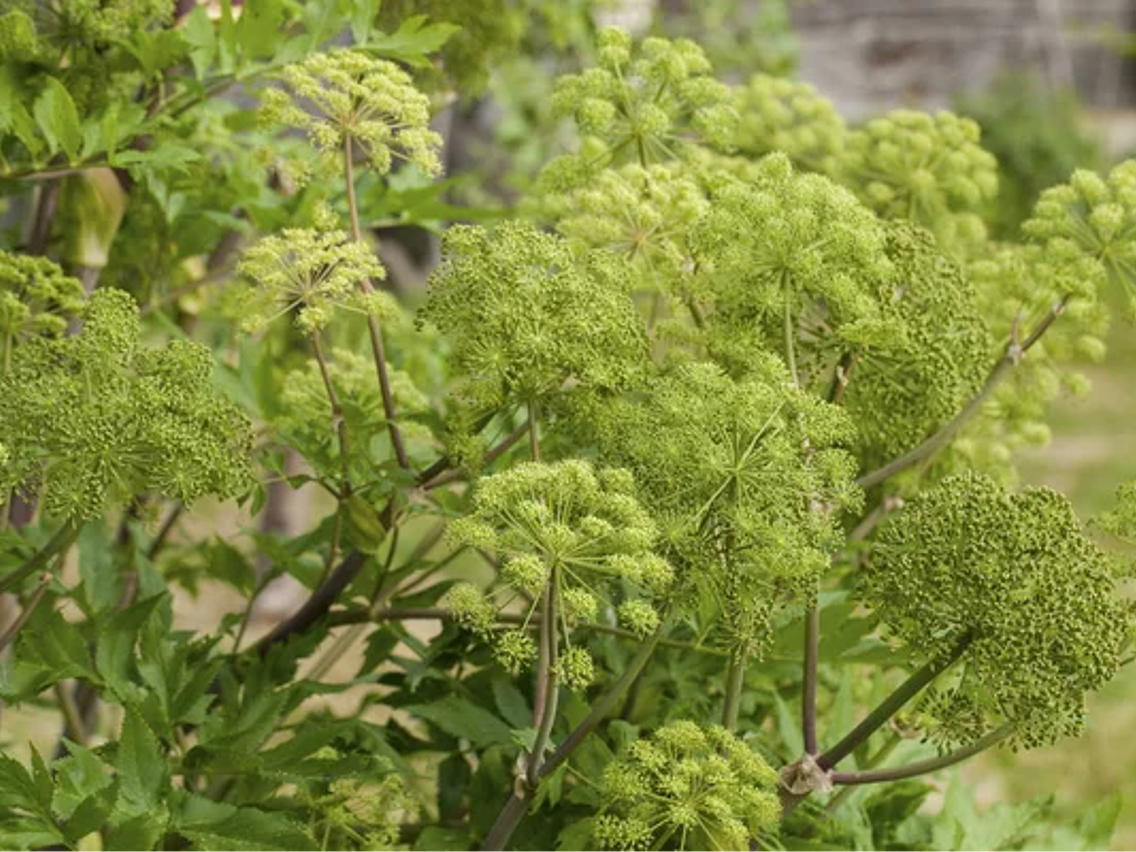Angelica - Garden Angelica

Common Names: Angelica, Garden Angelica, Wild Celery, Holy Ghost, Norwegian Angelica, Archangel, Angelica archangelica, Angelica officinalis, European Angelica, Dong Quai (for the related species), Archangelica, Root of the Holy Spirit
Latin Name: Archangelica officinalis
Origin: Asia, Europe
Short Introduction
In our temperate climate, Angelica can be found commonly in the wild, making it accessible beyond the offerings of herbal tea vendors and dried herb suppliers for those with access to nature. However, it is essential to carefully identify the plant before foraging, especially if the intention is therapeutic use, to avoid potentially harmful confusion with similar, toxic species. Cultivating Angelica is considered easy, as long as the plant receives sufficient moisture. For healthy growth, Angelica requires moist soil or proximity to a water source. Growers following this simple guideline can expect the plant to thrive and soon enjoy the 'fruits' of their labor.
Detailed Description
Angelica, also known as Garden Angelica, is a tall, aromatic biennial herb cherished for its edible stems and roots, as well as its distinctive, sweet fragrance. It is both a valuable culinary and medicinal plant, and care must be taken during harvesting due to its resemblance to some toxic relatives.
Botanical Information
Angelica (Angelica archangelica) is a biennial herb widely cultivated for its edible, sweet-tasting parts—including especially the stems and roots. As a member of the Apiaceae (carrot or parsley) family, Angelica shares a similar appearance with related species, some of which are poisonous (such as hemlock), so precise identification is crucial for gatherers and herbalists. In its first year, Angelica produces only leaves and remains dormant; during its second year, it grows a hollow stem that can reach up to 2 meters in height. The leaves are compound, divided into smaller leaflets that are further subdivided, often grouped in threes, with finely serrated or lobed edges. Its many tiny, yellow-green flowers form showy, spherical umbel clusters.
Origin and Distribution
Angelica grows wild throughout northern Europe, including Finland, Sweden, Norway, Denmark, Iceland, and the Faroe Islands, and is cultivated in countries like France and Germany. It is also found across central and eastern Europe, with its natural range stretching all the way to southeastern Asia, including as far as Thailand. Angelica thrives in moist soils and flourishes near water, making these conditions essential for successful cultivation.
Usage / Dosage
The most therapeutically valued parts of Angelica are the root, its volatile oils, the dried root extract, and liquid root extract, although the dried leaves and seeds are also used in herbal practice. Dating back to the 10th century, Angelica has been used both as a vegetable and a medicinal herb, gaining particular popularity in Scandinavia around the 12th century for culinary and household uses—including as food, musical instruments, homeware, and even a milk-like sap with multiple uses.
Historically, Angelica was intentionally propagated because it was believed to help alleviate plague symptoms. Widespread use in monasteries is recorded from the late 16th century, where it was valued not only for decoration but also for its spiritual significance. For generations, Austrian folk medicine has relied on Angelica tea or tincture to address gastrointestinal issues, respiratory conditions, nervous system problems, fevers, early signs of infectious diseases, and the flu.
While Angelica has not been as widely used in traditional Western herbalism, its close relative, Dong Quai (Angelica sinensis), remains a staple in Chinese medicine, especially for gynecological concerns, menstrual discomfort, and menopausal symptoms. Angelica is also used to address inflammatory joint diseases (arthritis), and baths made from Angelica infusions are recommended for relaxing sore muscles after physical exertion. Additionally, Angelica is prized as a nervous tonic to help ease nervous tension and migraines, and supports overall relaxation.
Angelica distinguishes itself with a charismatic, unmistakable aroma unique among aromatic plants and highly valued in perfumery. The roots are likewise aromatic and frequently used in culinary and medicinal recipes.
Active Compounds
Angelica's most prominent active components are the coumarins (notably angelicin, osthol, imperatorin, and others), which are especially concentrated in the fresh roots. The essential oil, produced by distillation, can contain up to five times the active constituents found in the fresh root. Other important compounds include essential oils, a range of terpenes, and various organic acids, each found in different parts of the plant and in varying concentrations, depending on the extraction method employed.
Traditional Dosage
Many parts of Angelica may be used, either fresh or processed. The most common method is to use dried (or powdered) root as an infusion, typically 1–2 grams per 250 ml, up to three times daily. Liquid root extract (tincture) is made at a 1:1 ratio with 25% alcohol; a gradually increasing dose of 0.5–2.0 ml, three times daily, may be taken for more than a month. For pure Angelica essential oil, the recommended dose is 1–5 drops (about 0.05–0.2 ml), up to three times daily.
